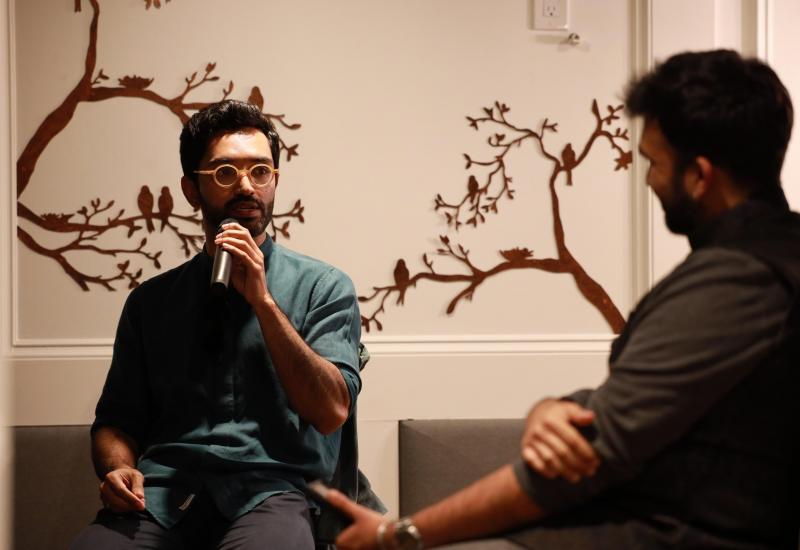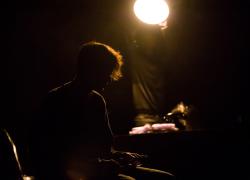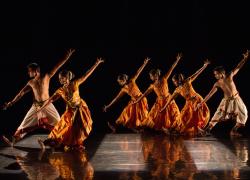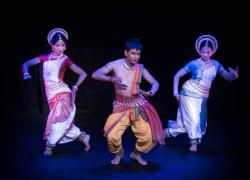The Dynamics of Displacement: Who were the bar girls?
Sanjoy Roy interviewed Anna Morcom about her book Illicit Worlds of Indian Dance, on courtesans, bar girls and transgender performers.
UNIVERSITY LECTURER ANNA MORCOM hadn’t planned to look at the largely uncharted grey areas that connect performance with prostitution, a wide expanse filled with shades of commerce and culture, with the overtones of seduction and sex. Back in 2006, having finished her doctoral thesis on Hindi film songs, she decided to go to Mumbai to begin a new project on women and Bollywood dance. But events took a different turn.
She arrived in the aftermath of a Maharashtra-wide ban on dance bars – drinking clubs, patronised by men, featuring erotic dancing by women, which had become the centre of a rumbling political and media storm with the “bar girls”, as they were called, at its eye. “I heard that the bar girls typically danced to Bollywood music,” Morcom tells me when I meet her in her south London home, “so I just thought I should go and find out more.” When she met them, what she found found was not what she expected. “I discovered that a large proportion of the bar girls – some say 70%, some say 80% – came from hereditary performing families. And I thought: wow – these are the courtesans, the tawaif!”
The tawaif were most widely known as the elite courtesan singers and dancers who would perform in the courts of north India in the eighteenth and nineteenth centuries. They were an integral part of the lineage of kathak dance, and have been mythologised in such films as Pakeezah (1972) and Umrao Jaan (1981). But along with other hereditary performing groups – loosely, the nautch in the north India, who were linked to Mughal courts and kathak dance, and the devadasis in south India, who were linked to Hindu temples and bharatanatyam – the tawaif were ostracised following the anti-nautch movements of the late nineteenth and early twentieth centuries, which labelled them as prostitutes rather than performers. They gradually disappeared from public view, and classical Indian dance was reshaped and repositioned as a higher class art form. But what happened to those displaced performers?
“If you read about the history of Indian dance,” says Morcom, “you can get the vague impression that the tawaif and devadasis just sort of disappeared as a new order came in. But here I’d found some of their descendents working as bar girls in Mumbai, who traced a lineage back to those earlier days.” What struck Morcom most forcefully was not simply that she had stumbled upon hereditary communities that she vaguely thought must have dispersed or died out, but that the vociferous public debates over the bar girls echoed almost exactly the reformist anti-nautch campaigns of the previous century. “The arguments used to ban the bar girls,” she says, “were the same as those used against the courtesans and devadasis over a century earlier. They were labelled prostitutes, and opposing voices argued that they were either wrecking society or that society was wrecking them. Both sides favoured the ban. And what staggered me was not just that the same arguments were being replayed, but that they were being used against the same people.”
And thus began a rather different project from the one Morcom had set out to undertake, the results of which have now been published in a book entitled Illicit Worlds of Indian Dance (in the UK) or Courtesans, Bar Girls, and Dancing Boys (in India). It is an academic book – not an easy read, certainly, but thoroughly researched. Its tone is the very opposite of polemic: it refrains from moralising, and is careful to draw arguments from evidence. It approaches its subject first and foremost as a matter of performance, and only secondarily deals with sex work.
In brief, it covers the following ground. It recaps the history of the anti-nautch movement in the reshaping of Indian classical dance. It pulls together a range of studies on a wide variety of hereditary performing communities in India in order to build an ethnographic picture of the field. In contemporary India, it looks at the bar girls’ controversy, at the increasing legitimisation of Bollywood dance as a kind of eroticised performance, and at the kothis and zenanas – men who perform female roles, whether in traditional or in contemporary contexts – and their differences from and similarities to both female hereditary performers and to the more visible and widely studied hijras. Implicit in every chapter is an investigation of the erotics of performance and the performance of gender, of the cross-hatching of social, sexual and cultural economies.
It is a rich and wide-ranging book, but for me one idea stood out, simply because it seems so counter-intuitive. Morcom states it plainly: “The result of the ban on dance bars had the opposite effect of what either side intended. Instead of reducing prostitution, it produced more sex work, and more explicitly sexual performances.” Why would that happen?
“It’s connected to their loss of status and livelihood,” she explains. “It’s important to understand that not all sex work is the same. Of course, there is a patriarchal context, that is completely obvious. But compare a bar girl to a brothel or lodge-based sex worker, and the bar girl will be earning a lot more money and have a higher social status. She will be doing far fewer sexual transactions, have more control over them, and command a higher price for them. And her position is less high risk in terms of sexual health or violence.” In other words, ban the bar and you take away some of the few advantages that she has. “Yes. Lots of sources corroborated that the result of the ban was more sexualisation, more transactional sex, lower income and lower status.”
In her book, Morcom calls this “the dynamics of exclusion”, and sees its effects not only in the communities of bar girls, but in the hereditary performers who were once central to classical Indian dance from whom many of them descended. Eroticised performers (whether courtesans or bar girls) once had a “liminal” social role – that is, a recognised but unconventional and admittedly precarious place within society. But when that was removed, those people didn’t simply disappear along with their social space. Instead, they were displaced, becoming more like an illicit underclass – leaving them more open to exploitation, with fewer means of livelihood and less hope of improving their lot.
This was part of the dynamics of reformation. “The reason kathak and bharatanatyam were able to become more respectable,” says Morcom, “is first of all that the devadasis and tawaif were no longer there. So your middle or upper-class spectator wouldn’t be confused: you could not have a devadasi performer next to a brahmin girl. Secondly, the way middle and upper class women performed was quite different. A lot of the poetry was made less erotic, or erotic texts were adapted to make them more devotional. The dancer would perform on a stage rather than to a specific male audience or patron. Whereas a courtesan might sing a ghazal, and address her words to a male spectator, the concert dancer is generally accompanied by a singer or a recorded voice, so that the performance acts out the words in a more abstracted, less directed way.”
Morcom’s angle is striking: rather than recounting a history of Indian dance through its forms, it recounts a more hidden, sociological history of its performers. Those performers were once liminal, but after ostracisation they became illicit. “They have a real sense of loss,” she says, “and a depression about their profession. They know that they used to have a real status, and that they have lost it.”
Morcom is no polemicist, and recognises the sensitivity of her subject. But on one point she is adamant: “Some people still say that these contemporary communities of performers have nothing to do with the real classical tradition. And that is just not true.”
Truth, and truthfulness, are what motivated motivated Morcom to write the book in the first place. “In the case of the bar girls, there was this obsessive media focus on whether or not they were prostitutes, and polarised arguments that either they were a social evil, or were victims who should be rescued. What wasn’t seen was that actually they have a history. They were neither exactly prostitutes nor, obviously, were they respectable mainstream women. They were something else. I wanted to fill in their story with something more real.”
“I hope,” she adds, “that the book will help to cool down controversy. So that people can talk about the subject. Extremist debates between polar opposites just heat everything up and everybody just shouts more, which is not helpful. We need to understand who these human beings are and what their concerns are in a more nuanced way. My motivation with this research was to make people think more. Because a lot of bad things happen in the world when we see things in black and white and don’t see the grey areas.”
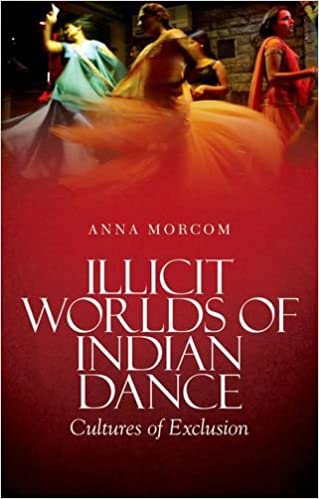
This article was first published in Pulse Issue No. 129, Summer 2014








